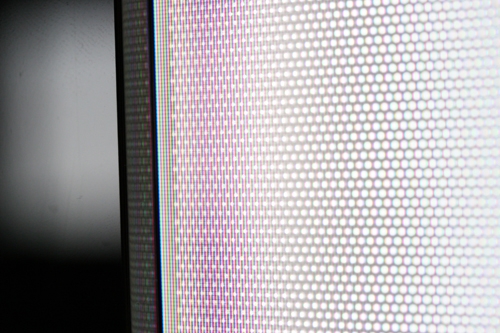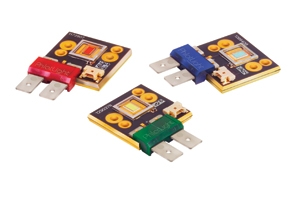Guide To LED Technology Page 2

Image at bottom left: An edge-lit LED/LCD TV light guide plate. The grid of reflective bumps help distribute light from the screen's edges towards its center.
EDGE-LIT: A WORTHY CONTENDER?
Edge-lit LED/LCD TVs are simpler and generally less expensive to manufacture than fullarray models. According to research firm DisplaySearch, the actual cost of materials can be 30% to 40% less. Edge-lit TVs have white LEDs implanted all around the bezel, behind the LCD panel. The LEDs are positioned so that the light beams sideways toward the screen's center, parallel to it and perpendicular to the line between viewer and screen.
The light guide plate, a large sheet of reflective material that's covered with tiny convex bumps, reflects the side-fired light at a 90° angle so that it passes through the LCD panel to the viewer. The bumps are taller toward the center of the screen, where light coming from the LEDs is weakest; these higher bumps have a higher reflectivity to make up for the weaker light in the center. Because the light guide plate contains many thousands of reflective bumps, most edge-lit sets need no diffuser panel. The LEDs illuminating an edge-lit LCD can be also dimmed to produce deeper blacks, but they can be dimmed only as a group, not individually.
The advantage of edge-lit LED/LCD TVs is that they can be made exceptionally slim. For example, the latest Samsung models measure 1.2 inches thick - much slimmer than the 4-inch-thick LCD TVs of just a few years ago. However, the company's recent full-array models are almost as slim, measuring a mere 1.5 inches thick. As Jonas Tanenbaum, Samsung vice president of LED and LCD marketing, says, "Edge-lit may always enjoy an advantage in slimness, but once you get to a 1.5-inch depth [with a fullarray TV], how perceptible is that extra 0.3 inches?" Because edge-lit TVs use fewer LEDs and no diffuser screen, they also tend to be more energy-efficient than full-array TVs, despite the fact that the LEDs in an edge-lit TV can't be dimmed locally.
 A cross-section view of a typical edge-lit LED/LCD TV.
A cross-section view of a typical edge-lit LED/LCD TV. The main disadvantage of edge-lit LED/ LCD TVs is that they usually can't match the extremely high contrast ratios achieved by full-array TVs. They can also suffer image uniformity problems stemming from imperfect light plate designs that don't evenly distribute the light from the LEDs, and from mild "hot-spotting" caused by the lack of a diffuser. However, you wouldn't notice the latter two issues except in certain situations, such as movie scenes that fade to black.
Videophiles generally consider full-array LED/LCD TVs to offer better picture quality because of the deeper blacks created by local dimming. But the point is debatable. In many movies and TV shows, you would appreciate the potentially lower black level of fullarray TVs in only a few scenes - and in those scenes, blooming may be visible. Edge-lit TVs can actually deliver better contrast in certain situations and scenes, because while the shadow depth may be somewhat less than with a full-array model, white highlights in the picture can also be brighter due to the set's greater efficiency.

Red, green, and blue PhlatLight LEDs. These flash light sequentially at a front projector's DLP chip to produce images.
Edge-lit displays may also offer somewhat smaller viewing angles compared with full-array models, because the light coming from the LED array through those sets' diffuser panel is more broadly distributed than the light coming off the reflector bumps on a light guide panel. Thus, an edge-lit TV's brightness may drop off a bit if you're viewing it from an angle. Neither technology, though, can match the broad viewing angle of a plasma TV.
- Log in or register to post comments



































































